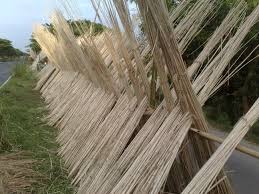About Jute
Jute is a long, soft, shiny vegetable fiber that can be spun into strong threads. It is produced primarily from plants in the family Corchorus. It is one of the most affordable natural fibers, and second only to cotton in the amount produced and variety of uses. Jute fibers are composed primarily of the plant materials cellulose and lignin. The fibers are off-white to brown, and 1–4 metres (3–13 feet) long. Jute is also called the golden fiber for its color and high cash value.

Some Benefits Of Jute

Needs Very Little Water
As a natural plant fiber, jute can be grown and harvested over and over again with very little water needed. In this era of water conservation is great for our planet.
Less Need for Fertilizer, Herbicides and Pesticides
Jute can grow with very little need of chemical assistance in the form of fertilizer, herbicide or pesticide, so that means fewer chemicals are emptied into the soil.
Grows Quickly
The jute growing season is about 100 days, so there is a quick turnover and a constant supply of more fiber.
Improves Soil Condition, Texture and Fertility
Jute replenishes soil nutrients and reduces the risk of pests and disease so when crops are rotated after the jute has been harvested, future plants will be better off for it.
Cost Effective
There is very little expense when it comes to growing jute since the plant does not require much in the way of fertilizers, pesticides and such, and a small area can turn out a lot of crop, so jute is typically a profitable crop and can be very cost effective.
Biodegradable
As a natural fiber jute is biodegradable, so once it has served its purpose it can be composted or if it ends up in a landfill it will naturally breakdown with no ill effects.
Reduces Plastic Pollution
Reusable shopping bags constructed from jute reduce the need of single-use plastic bags. Only a small percentage of disposable plastic bags are recycled; the vast majority of these single-use bags end up in landfills or as litter. Using a jute grocery bag does away with the need of disposable bags and the resulting pollution.
Comfort
When woven into material, jute can be very comfortable. This is a nice benefit whether jute fabric is used for clothing or fashioned into a reusable bag.
Recyclable
Jute can be recycled again and again, so new life can constantly be breathed into existing fibers.
Cleansing the Air
Studies have shown that 1 hectare of jute cultivation can absorb up to 15 tons of carbon dioxide and release 11 tons of oxygen during the jute growing process (about 100 days) a benefit for our environment and planet, for a green and sustainable development.
Lowers the Burden From Natural Oil Reserves
Plastic and poly bags are made from petroleum. Petroleum resources are depleting very fast, which results in an increase in petroleum price and inflation rate.
More Land Available for Food production
Jute cultivation requires less acreage to grow. One hectare of field can produce much more jute fibre than one hectare of cotton cultivation. This acreage reduction allows more food crops and therefore reduces risk of food inflation.
Backward Rural Area situation is improved
Jute is mostly cultivated in the backward areas of India and Bangladesh near the coast of Bay of Bengal. The building of jute industries in these regions would increase employment and development of backward rural and remote areas, and consequently less migration to urban areas.